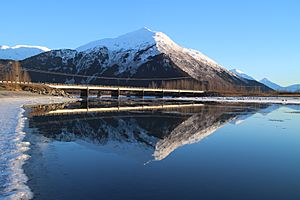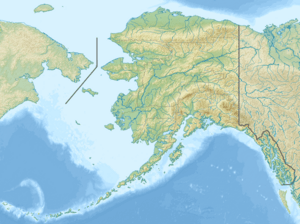Twentymile River facts for kids
Quick facts for kids Twentymile River |
|
|---|---|

Twentymile River at its delta at the Seward Highway bridge. (Portage Peak in the background)
|
|
|
Location in Alaska
|
|
| Country | United States |
| State | Alaska |
| City | Portage |
| Physical characteristics | |
| Main source | Various small glaciers |
| River mouth | Turnagain Arm Portage 0 m (0 ft) 60°50′43″N 148°59′21″W / 60.8452°N 148.9893°W |
| Length | 20 mi (32 km) |
| Basin features | |
| Tributaries |
|
The Twentymile River is a cool river found in Alaska, near the Kenai Peninsula. It starts high up in the Chugach Mountains. The water comes from several small glaciers melting. This meltwater flows down into a wide valley. Along its journey, other rivers like the Moraine River and Glacier River join it. After flowing about 20 miles (32 km), the Twentymile River reaches its end. It empties into a large bay called Turnagain Arm. Here, it forms a big, marshy area called a delta. This delta is next to the deltas of Portage Creek and the Placer River. Many people think the river starts at Twentymile Glacier, but that's not actually true!
Contents
Exploring the Twentymile River
The Twentymile River is an important natural feature in Alaska. It helps shape the land around it. Rivers like this are vital for the environment. They provide homes for animals and plants. They also carry water and nutrients across the landscape.
Where Does the River Begin?
The Twentymile River starts in a remote valley. This valley is high up in the Chugach Mountains. The water that forms the river comes from melting ice. This ice is part of several small glaciers. Glaciers are like giant, slow-moving rivers of ice. As they melt, they release water. This water then flows downhill, forming the river.
The River's Journey to the Sea
As the river flows, it gets bigger. It travels through a wide valley. Along the way, it meets other rivers. The Moraine River and the Glacier River are two of these. They are called tributaries. Tributaries are smaller streams or rivers. They flow into a larger river.
Reaching Turnagain Arm
The Twentymile River flows for about 20 miles (32 km). Its journey ends when it reaches Turnagain Arm. This is a long, narrow body of water. It is part of the Cook Inlet. The river empties into Turnagain Arm near a place called Portage.
What is a River Delta?
When a river reaches a larger body of water, it often slows down. This causes it to drop the dirt and rocks it has been carrying. Over time, these materials build up. They form a flat, marshy area called a delta. The Twentymile River forms a broad delta. It is next to the deltas of Portage Creek and the Placer River. Deltas are often rich in wildlife. They are important habitats for many species.
Wildlife and Environment
The area around the Twentymile River is full of life. Rivers and their deltas create unique ecosystems. These ecosystems support many different plants and animals.
Animals Living Near the River
Rivers in Alaska are home to many creatures. Fish like salmon often swim in these waters. They travel upstream to lay their eggs. Bears and eagles might be seen hunting for fish. Moose and other mammals also live in the surrounding forests. The marshy delta provides a great home for birds. Many types of waterfowl can be found there.
Plants of the River Valley
The river valley and delta have special plants. These plants can grow in wet, marshy soil. Grasses, sedges, and various shrubs are common. These plants provide food and shelter for the animals. They also help to hold the soil in place. This prevents erosion.
Human Connection to the River
People have lived near and used rivers for thousands of years. Rivers provide water, food, and transportation. The Twentymile River is no exception.
The Seward Highway Bridge
A bridge crosses the Twentymile River. This bridge is part of the Seward Highway. The Seward Highway is a major road in Alaska. It connects the city of Anchorage to the Kenai Peninsula. The bridge allows people to travel easily. It also offers great views of the river and the surrounding mountains. Portage Peak can be seen in the background.



